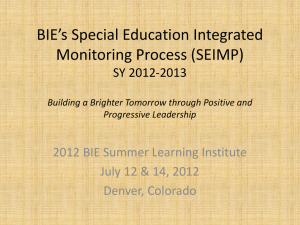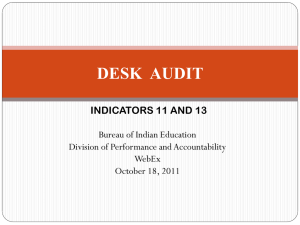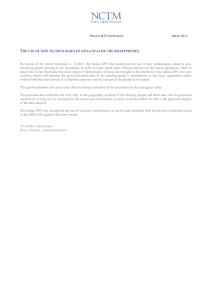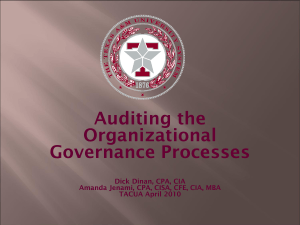Special Education Integrated Monitoring Process
advertisement
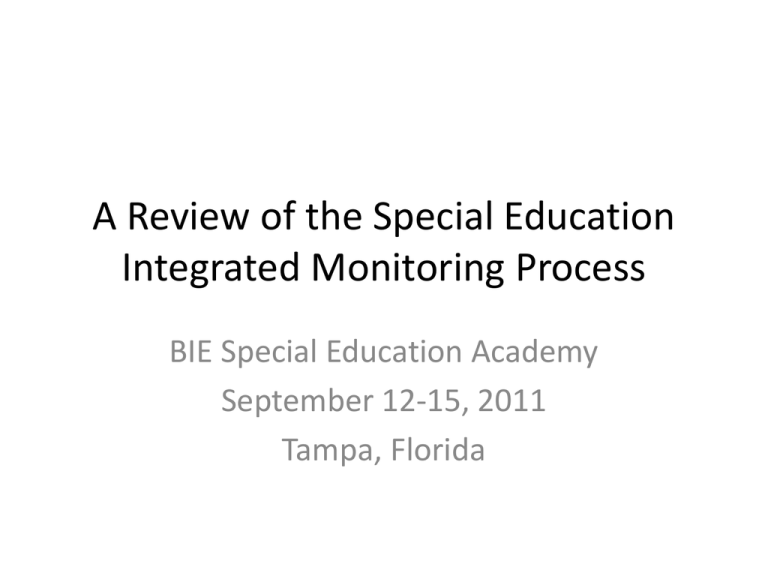
A Review of the Special Education Integrated Monitoring Process BIE Special Education Academy September 12-15, 2011 Tampa, Florida Overview • The BIE must: – monitor the school’s implementation of Part B, – enforce Part in accordance with the provisions of 34 CFR 300.604(a)(1), and (a)(3), (b)(2)(i) and (b)(2)(v), and (c)(2) – Annually report on performance under Part B. Authority to Monitor • IDEA, 20 U.S.C. 1400 (d)(1)—provides federal funds to help states in educating children with disabilities and requires states to comply with IDEA requirements • Section 616—provides focus – Improving education results/functional outcomes – Ensures that state meet program requirements Purpose of Monitoring • Improve educational results and functional outcomes for all children with disabilities • Ensure that program requirements under Part B, with a particular emphasis on those requirements that are most closely related to improving educational results for children with disabilities are met Monitoring Priorities • Provision of FAPE in the least restrictive environment • General supervision (including child find, effective monitoring, use of resolution sessions, mediation, and a system of transition services) Monitoring Schedule • September to October 2011—58 on-site visits • November 2011—Desk Audit (Indicator 11 & 13) • December 2011—Written notification of finding(s) • January 2012—School implements required action plan prescribed by the BIE/DPA to correct finding(s) within required timelines 3 Components 1. Desk Audit Indicator 11—timely initial evaluations Indicator 13—secondary transition 2. Focused Monitoring 3. Other ISEP Dispute Resolution Parent Concerns DESK AUDIT—Indicator 11 (timely initial evaluations) • Part B Requirements: – Initial evaluation must be conducted within 60days of receiving parent consent • Indicator 11 target is 100% compliance Data • Data will be reviewed through an annual desk audit in NASIS: – Signed parent consent form to evaluate was received by the school – Signed determination of eligibility form within 60-calendar day timeline Selection Criteria • All BIE-funded schools with an academic program will be monitored through NASIS every November Process—School responsibility 1. upload two signature documents for each initial evaluation into the NASIS Special Education Module – Signed Parent Consent form – Signed Determination of Eligibility Process 2. DPA responsibility • Written notification to all schools—September of each year. • WebEx training on October 18, 2011 • Electronic desk audit form will be posted on BIE website/Special Education. 3. Schools complete the electronic desk audit form with the following information: • School Name • Number of Parent Consent received for initial evaluations • School Contact Person Process 4. Schools to submit desk audit form to BIE/DPA by November of each year. 5. DPA conducts desk audit and verifies documents uploaded in NASIS. Tips for Desk Audit Form • Enter the NASIS number • Enter Zero or 0 if the school had no initial evaluations on the Desk Audit form. DESK AUDIT—Indicator 13 (secondary transition) • Purpose to ensure students • Files reviewed in NASIS • Indicator 13 target is 100% compliance for all high schools Data • Part B requirements: For students 16 and older, or will turn 16 during the duration of this IEP, there are appropriate measurable post-secondary goals that cover education, training, employment, and, as needed independent living skills. CFR300.320(b)(1) Post-secondary goals updated annually. CFR300.320(b) Evidence that post-secondary goals were based on age appropriate transition assessments (CFR300.320(b)(1) – Transition services that will reasonably enable the student to meet his/her post-secondary goals. CFR300.320(b)(2) – Course of study that will reasonably enable the student to meet his/her post-secondary goals. CFR300.321(b)(2) Data • Evidence that student was invited to the IEP meeting when transition services were discussed. CFR300.321(b)(1) • If appropriate, evidence that a representative of any participating agency was invited to the IEP meeting with prior consent of the parent(s) or student who has reached the age of majority. CFR300.321(321)(b)(3) • NO later than one year before the students reaches the age of majority under State law, a Statement that the child has been informed of his/her rights on reaching the age of majority is included. CFR300.3219321 Process 1. March—all high schools receive written communication from BIE/DPA for Indicator 13 desk audit 2. WebEx training—October 18, 2011 3. BIE/DPA will post desk audit form on BIE website. 4. DPA will conduct the desk audit of 8 items FOCUSED MONITORING Data Presentation • Indicator 15—timely correction of noncompliance • Schools must meet target at 100% • Noncompliance must be corrected as soon as possible and no later than one-year of written notification • Noncompliance not corrected within one-year, enforcement action is applied Selection Criteria • • • • 58 schools selected each year Top 10 reading/math proficiency scores Low 48 reading/math proficiency scores Not on a corrective action plan Process • Desk Audit—Special Education Data Summit – Review of special education data – Identifies regulatory requirements in need of improvement • Data Analysis – Focus of monitoring activities identified • xx Targeted Technical Assistance • Helps schools to correct noncompliance, improve results, provide promising practices, and dissemination information – National Level – Regional or ELO level – School level – Individual students with disabilities – Other resources Roles and Responsibilities • Schools—correct noncompliance; correctly implement specific regulatory requirements; provide special education/related services • Education Line Officer—knowledge of school noncompliance; provide guidance to schools; follow through on correction process • Grantee/School Board—knowledge of school noncompliance; knowledge of enforcement action; provide support and direction for school • BIE/DPA—verify schools correct and implement specific regulatory requirements; report continuing noncompliance in annual APR and PIAP quarter reports Identifying Noncompliance by Other Activities • • Indian Student Equalization Program (ISEP) 25CFR Subpart D - Accountability Special Education - Education Line Officer (ELO) Responsibility • Each school must maintain and individual file on each student receiving basic educational and supplemental services. • ELO is responsible to conduct an on-site ISEP Special Education Certification file review. • The ELO verifies and certifies that the students with disabilities attending the school are receiving special education services as indicated on the student’s Individualized Education Program (IEP). • School is required to have 100% compliance on the ISEP special education certification roster. If ELO identifies noncompliance items, must inform the school that they have 30 calendar days from the date of the review to correct noncompliance item(s). Identifying Noncompliance by Other Activities • Verification of Correction • School required to correct noncompliance and submit the revised certification roster to their line officer. • ELO verifies that individual correction(s) have been completed. The ELO signs and dates a statement verifying that corrections of special education noncompliance findings have been corrected. • ELO submits the ISEP Special Education Certification roster with or without the signed statement to the Division of Performance and Accountability (DPA) on or before December 31 of each year. Identifying Noncompliance by Other Activities • Special Education—Division of Performance and Accountability (DPA) Responsibility • Written Notification of Noncompliance • DPA will review the submitted rosters to determine if there are noncompliance items that the ELO was unable to verify as corrected within the 30-day timeline. • DPA will send a notification letter of noncompliance to the school, Education Line officer, and the Associate Deputy Director for that region no later than January 31. Identifying Noncompliance by Other Activities • Corrective Action Plan (CAP) – The school will have one year from the date of the notification letter to correct ISEP noncompliance item(s) and complete a Corrective Action Plan. The school will submit the completed CAP to DPA. – Upon receipt of the CAP the DPA will utilized the Native American Student Information System (NASIS) to verify that the individual findings of noncompliance have been corrected. Utilizing the submitted CAP the DPA will notify the school of close out(s) of noncompliance item(s). – DPA will review updated (NASIS) to ensure that the school is correctly implementing the specific IDEA regulatory requirements. Corrective Action Verification of Correction OTHER—DISPUTE RESOLUTION • Dispute resolution findings are findings of noncompliance • Parent or school can file due process OTHER—PARENT CONCERNS • Parent reports dissatisfaction with their child’s special education program, investigation is completed. As a result of the investigation, findings of noncompliance may be identified CORRECTION OF NONCOMPLIANCE OSEP Standard • One-year to correct noncompliance identified • Correct at 100% • Principle: students with disabilities are entitled to receive special education and related services in a timely manner Written Notification • Timeline to correct noncompliance begins the date DPA informs school that they are in noncompliance School Responsibility • Correct student-specific finding at 100% as soon as possible • Correctly implement the specific regulatory requirements of IDEA Verification of Correction • BIE/DPA responsibility: – Ensure school corrects at 100% – Ensure school correctly implements the specific regulatory requirements of IDEA based on the review of updated data and other documents – Timeline: within one-year of identification Updated Data • Updated data examined in NASIS to determine if school had correctly previously identified noncompliance and was correctly implementing the specific regulatory requirements of IDEA Summary • Findings of noncompliance must be corrected as soon as possible and have systems in place at the school level to sustain compliance with all special education laws and regulations ENFORCEMENT 2 Enforcement Actions 1. Intensive Targeted Technical Assistance 2. Enforcement Action Intensive Technical Assistance • 3 webinars: – Enforcement actions for not correcting noncompliance – Root cause analysis – Specific data analysis Enforcement Action • Written notification • Incremental distribution of special education Part B funds • School noncompliance reported to OSEP in Annual Performance Report (APR) and Program Improvement Accountability Plan (PIAP) • Continued noncompliance affects the school’s and BIEs level of determination by OSEP Thank You • Dr. Eugene Thompson • Dr. Fern Diamond
